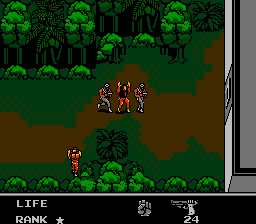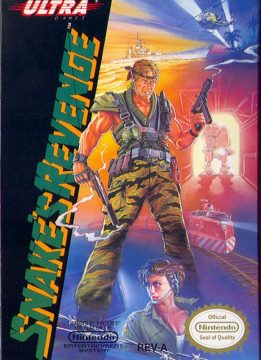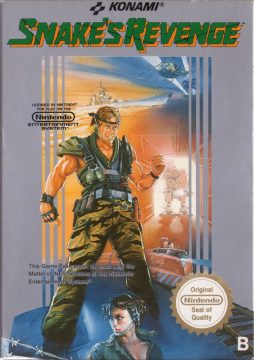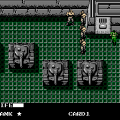- Metal Gear
- Snake’s Revenge
- Metal Gear 2: Solid Snake
- Metal Gear Solid
- Metal Gear Solid Integral Staff Commentary
- Metal Gear Solid (Game Boy Color)
- Metal Gear Solid 2: Sons of Liberty
- Document of Metal Gear Solid 2, The
- Metal Gear Solid: The Twin Snakes
- Metal Gear Solid 3: Snake Eater
- Metal Gear Solid 4: Guns of the Patriots
- Metal Gear Solid: Portable Ops
- Metal Gear Solid: Peace Walker
- Metal Gear Solid V: Ground Zeroes
- Metal Gear Solid V: The Phantom Pain
- Metal Gear Rising: Revengeance
- Metal Gear Touch
- Metal Gear Acid
- Metal Gear Acid 2
- Metal Gear Solid Mobile
Konami found substantial success with the NES in North America, and did what few others companies did – began producing titles specifically for the overseas audience. Of these half a dozen or so titles, one of them was a sequel to one of their biggest selling games – Metal Gear. Snake’s Revenge continues the story of Solid Snake, although it was done without the involvement of Hideo Kojima, much like the console port of the first game. This, and the fact that it was never released in its home country, has earned Snake’s Revenge the reputation of a bastard child, and not acknowledged to be part of the main canon. It also has a reputation of being a shoddy product, one that eschewed stealth elements in favor of action. This is actually pretty far from the truth – for the most part, it plays quite similarly to its predecessor, and isn’t an entirely terrible game, but it does have a number of annoying design flaws that keep it from greatness.
Part of the reason that Snake’s Revenge is disavowed from the timeline is the story. The NES Metal Gear had a silly plot in the English instruction manual that was written without any correlation to the in-game story, but at least gamers could look at Konami of Japan’s official story for the real deal. Not so with Snake’s Revenge. Since there was no Japanese release, and the in-game plot in minimal, the only background is a similarly ridiculous concoction by Konami’s American PR folks, making it impossible to take seriously. But the gist is, Snake is back to invade another fortress, stopping another maniac from creating another Metal Gear, and avenging some of his fallen friends in the process. The game doesn’t tell you until the very end, but the final leader is, once again, Big Boss. Snake is accompanied by two other members of Fox Hounder, Nick and John, in addition to Jennifer, presumably the same character from the first game, who has already infiltrated the base. The transmitter is used far less frequently than the first game, and the text clues are mostly useless. There is one section where you need to use the transmitter’s radar to find a beacon dropped by a helicopter, but otherwise the function goes unused.
Like the first game, Snake’s Revenge is focused primarily on stealth, although it’s actually quite a bit harder than the original. Your weapon’s range is limited, and alarms won’t stop until you’ve killed all of the enemies or ducked into an elevator. You have a knife to quickly take out enemies at short range, but you can still punch them to death, which has a small chance of dropping extra health or ammo. Getting killed (which will happen, a lot) will respawn you at the chapter start or last elevator you entered. In these ways, Snake’s Revenge is actually more faithful to the original MSX2 Metal Gear than the NES port.
Although the core is similar to the first game, there are a few additions and differences. There are searchlights you need to dodge, but only in the opening jungle stage. You can find particular enemy guards to interrogate, who give mostly information but add towards increasing your health, much like rescuing POWs. In order for them to spill their guts, you need to maintain a supply of truth gas. There are a few other items used throughout the game, like X-Ray Specs to spot hidden walls and a Flare Gun to illuminate rooms. There are also a few new weapons, like the Claymore Mines, which can be detonated on command and fire a spray of bullets in any direction, and a Shotgun, which also fires a spread shot. Snake’s Revenge is also quite a bit more linear than its predecessor. You’re free to explore a given level, but once you get past a certain point, you can’t go back, essentially dividing the game into chapters. For the most part, this reduces the tedious backtracking, so you only need to retrace your steps a bit if you miss an item. You’d better make sure you do this before completing an area, because once you pass the point of no return, you can’t go back.
The graphics are cleaner and brighter, with much more variety in both backgrounds and sprites. In addition to jungles and military bases, you also sneak through boats, trains and castles, which keeps things from blending together. Snake’s sprite, though, is remarkably ugly, as he’s now wearing bright red (on a stealth mission?) and his tiny head looks ridiculous next to his huge shoulders. The music is, per usual Konami standard, quite excellent, and features improved instrumentation from the original game.
The side-scrolling scenes are a big point of contention. At a few key portions, the game will switch to these side-scrolling areas as you infiltrate tunnels or ride tramcars. Much like the rest of the game, you have to try not to be spotted, but this is easier said than done. Most of your weapons are taken away, leaving you with only your knife, handgun and plastic explosives, but you can also jump. If you’re on the same horizontal level, you can crawl without being spotted, but you also can’t use your gun, requiring you to stab them. Movement is extremely sluggish, making it difficult to jump out of hiding and dispatch soldiers before they turn around and sound the alarm. There are also water pools filled with mines and electrical turrets, which are also difficult to maneuver around. These sections, however brief, only serve to aggravate, and the game would’ve been better off without them.
The other major demerit is the boss battles. They were somewhat awkward in the first game, but at least they were easy. Not so with Snake’s Revenge, where each and every single one is designed to infuriate. The first one has a small army of five soldiers which charge straight towards you for a few seconds before retreating and continuing. There’s not nearly enough room to maneuver, and it’s extremely difficult to avoid their attacks. The only solution, as with most of the boss battles, is to stock up on many rations as you can, and recharge as necessary. The game allows you to rank up to six stars this time, allowing a max of eighteen rations by the end, which is a necessity. But these won’t help you against the tank battle. Much like the first game, you need to destroy it by placing mines, but the tank can move between three different screens. You can set up mines but the tank may remain off screen for a minute or more. Furthermore, its movements are random, so the tank may, at any point, pop up on screen and immediately kill you if you’re too close to it.
The next-to-last battle against Big Boss is similarly infuriating. After littering him with bullets, he morphs into a giant, Snatcher-like cyborg and shoots exploding bullets. You need to lure him away from his room – a necessary step only vaguely explained by a clue from a POW, because if you don’t, he’s mysteriously invincible – and then try to get him to step on land mines. Unlike the NES Metal Gear, you actually get to fight against a Metal Gear this time, as it remains completely stationary. Here, you just get to flex your skills with the remote control missile by guiding them through a narrow corridor and hitting its weak point, all under a time limit. This is cake compared to the rest of the mission.
If you’ve got the patience to deal with the terribly designed side-scrolling sections and the infuriating boss battles, then Snake’s Revenge is a halfway enjoyable game. But even then, it’s not really “better” than its predecessor, it’s just harder. At least it’s credited with inspiring the “true” sequel, as Kojima learned about the game during its production and decided to start work on his own version, which became Metal Gear 2: Solid Snake for the MSX2.




